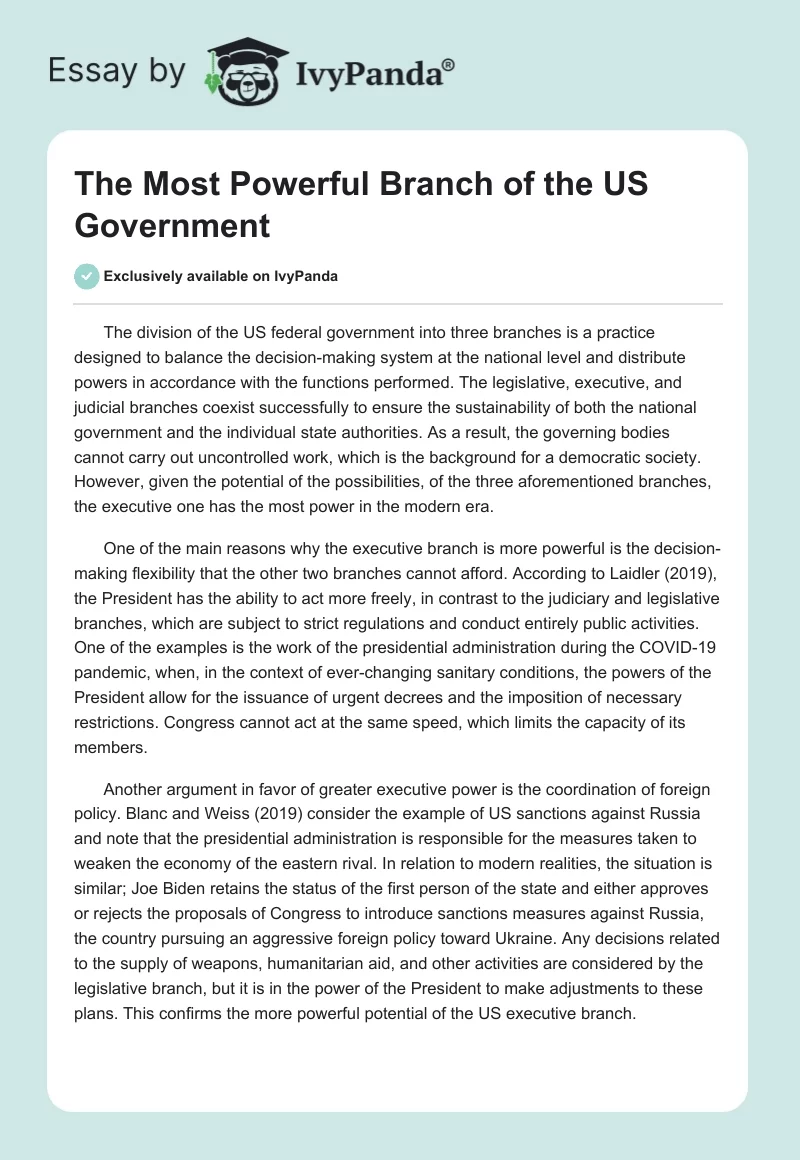
In the realm of civics, the question of which branch of government holds the mantle of power is both profound and multifaceted. As we dissect this inquiry, it is vital to recognize that the United States government is composed of three principal branches: the Executive, the Legislative, and the Judicial. Each branch is imbued with distinct powers and responsibilities, designed to facilitate a system of checks and balances that prevents the concentration of power in any one entity. Yet, within this intricate tapestry, one may ponder which branch emerges as the most powerful, wielding the most influence over the governance of the nation.
To comprehend the dynamics of power, we must first examine the respective functions of each branch. The Legislative Branch, composed of the House of Representatives and the Senate, is the bastion of lawmaking. Its dual chambers are tasked with the responsibility of crafting, debating, and enacting legislation that governs the populace. The Legislative Branch also holds significant powers, including the authority to levy taxes, regulate commerce, and declare war. Moreover, it possesses the unique capacity to impeach members of the Executive or Judicial branches, thereby serving as a powerful tool of accountability.
In juxtaposition, the Executive Branch, helmed by the President of the United States, is charged with the enforcement and administration of laws. The President, as the Commander-in-Chief, wields considerable authority over the military and foreign affairs, including the capacity to negotiate treaties and oversee diplomatic relations. The executive capabilities extend to the issuance of executive orders and vetoing legislation, providing a mechanism through which the President can shape policy directions and legislative outcomes.
The Judicial Branch, comprised of the Supreme Court and lower federal courts, serves as the arbiter of justice. This branch interprets laws, ensuring that they align with the Constitution. Its power extends to judicial review, allowing it to invalidate legislation or executive actions that it deems unconstitutional. The interpretive authority of the judiciary has far-reaching implications, often serving as a counterbalance to the actions of the Legislative and Executive branches.
With an understanding of these foundational components, we delve into a critical analysis of power dynamics. The Legislative Branch frequently lays claim to supremacy in the governmental hierarchy, holding the purse strings of the nation and the power to enact laws that govern daily life. However, its efficacy is curtailed by the necessity of compromise and consensus-building, which often leads to protracted legislative processes and gridlock.
Conversely, the Executive Branch, particularly in times of national crisis, can often assert its dominance through decisively swift actions. The ability of the President to act unilaterally, such as during military engagements or in declarations of emergency, grants this branch a fluidity of power that can be exceedingly impactful. However, such actions are not without contention. The balance of power remains delicately poised, as the Legislative Branch retains the authority to check and challenge executive overreach.
The Judicial Branch, while sometimes perceived as the least powerful, carries an inherent strength through its role as interpreter of the Constitution. Landmark Supreme Court cases have delineated the contours of rights and liberties, influencing societal norms and governmental actions. Its authority to nullify legislative or executive acts can embolden its stature, leading many to consider its role as pivotal in safeguarding democracy and upholding constitutional governance.
As the debate continues, an underlying theme emerges: the distribution of power among the branches is not a static concept but rather a fluid interplay influenced by historical context, public opinion, and extraordinary circumstances. The shifting tides of authority can often pivot based on the prevailing political landscape, with different branches gaining prominence at different junctures in history. For example, during times of war or national emergency, the Executive branch may overshadow the Legislative, whereas periods of legislative activity may empower Congress disproportionately.
Additionally, the increasing politicization of the judiciary has fostered debates regarding the legitimacy of its power. As judges and justices are often appointed based on their ideological leanings, the perception of impartiality can be challenged, thereby impacting public trust. Thus, the question of which branch is most powerful cannot be divorced from broader societal considerations, including the evolving notions of democratic legitimacy and accountability.
Moreover, the impact of public engagement cannot be overlooked. Grassroots movements, public opinion polls, and media coverage play a vital role in shaping the authority of each branch. An informed and active citizenry can empower the Legislative Branch, mobilizing for change and influencing policymakers, while public support can lend credence to executive initiatives or judicial decisions. The power dynamics are continually displaced by the will of the people, signifying that power is not merely an attribute of branches, but a collective manifestation influenced by the citizenry.
Ultimately, determining the most powerful branch of government requires an astute recognition of its contextual nature. As we probe into the layers of responsibility and authority, it becomes evident that while one branch may assert its influence at a particular moment, the interconnectedness and checks inherent in the system ensure that power remains in a state of equilibrium. Thus, the contemplation of power within the US government transcends mere classification and invites a deeper inquiry into the very essence of democracy itself.
In conclusion, the question of which branch of government is the most powerful should inspire continued curiosity and examination. The interplay of authority between the Legislative, Executive, and Judicial branches is reflective of a broader narrative—one centered on accountability, representation, and the enduring quest for a balanced governance structure. To assert that one branch is definitively more powerful than another could undermine the intricate and dynamic relationships that epitomize the United States’ commitment to democracy.
